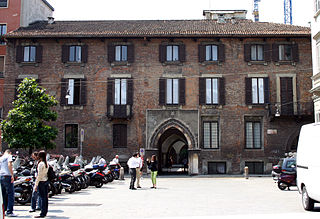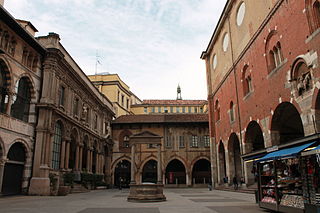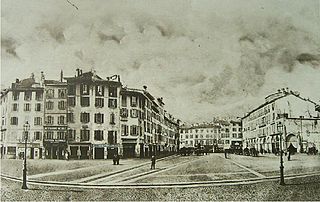

The Loggia degli Osii is a historical building of Milan, Italy. It is located in Piazza Mercanti, a central city square of Milan that used to be its centre in the Middle Ages.


The Loggia degli Osii is a historical building of Milan, Italy. It is located in Piazza Mercanti, a central city square of Milan that used to be its centre in the Middle Ages.
It was built in 1321 by order of Matteo I Visconti, lord of Milan, who wanted a series of porticoes near the Palazzo della Ragione to house the judicial and notary activities of the city. The name derives from that of the Osio family, who held some palaces in the area before its construction. The Loggia was designed by Scoto da San Gimignano.
Sentences and edicts were proclaimed by the Milanese judges from the Loggia's balcony (known as parlera), decorated with an eagle holding a prey, symbol of justice.
The edifice has a Gothic style portico and loggia in the façade; not usual for the Milanese Gothic structures is the white and black marble decoration: this, more common in Genoa at the time, is perhaps a homage to Matteo Visconti's wife, Valentina Doria.
The two loggias are surmounted by a series of triple mullioned windows, housing statues. These were realized by Ugo da Campione and his son Giovanni, by other masters from Campione d'Italia and Tuscany, in the 14th century.

Monza is a city and comune (municipality) on the River Lambro, a tributary of the River Po, in the Lombardy region of Italy, about 15 kilometres north-northeast of Milan. It is the capital of the province of Monza and Brianza. Monza is best known for its Grand Prix motor racing circuit, the Autodromo Nazionale di Monza, which hosts the Formula One Italian Grand Prix.

Vigevano is a comune (municipality) in the province of Pavia, in the Italian region of Lombardy. A historic art town, it is also renowned for shoemaking and is one of the main centres of Lomellina, a rice-growing agricultural district. Vigevano received the honorary title of city with a decree of Duke Francis II Sforza on 2 February 1532. It is famed for its Renaissance Piazza Ducale in the centre of the town.

Milan Cathedral, or Metropolitan Cathedral-Basilica of the Nativity of Saint Mary, is the cathedral church of Milan, Lombardy, Italy. Dedicated to the Nativity of St. Mary, it is the seat of the Archbishop of Milan, currently Archbishop Mario Delpini.

The Visconti of Milan are a noble Italian family. They rose to power in Milan during the Middle Ages where they ruled from 1277 to 1447, initially as Lords then as Dukes, and several collateral branches still exist.

The Archdiocese of Milan is a Latin Church ecclesiastical territory or archdiocese of the Catholic Church in Italy which covers the areas of Milan, Monza, Lecco and Varese. It has long maintained its own Latin liturgical rite usage, the Ambrosian rite, which is still used in the greater part of the diocesan territory. Among its past archbishops, the better known are Ambrose, Charles Borromeo, Pope Pius XI and Pope Paul VI.

Bernabò or Barnabò Visconti was an Italian soldier and statesman who was Lord of Milan. Along with his brothers Matteo and Galeazzo II, he inherited the lordship of Milan from his uncle Giovanni. Later in 1355, he and Galeazzo II were rumoured to have murdered their brother Matteo since he endangered the regime. When Galeazzo II died, he shared Milan's lordship with his nephew Gian Galeazzo. Bernabò was a ruthless despot toward his subjects and did not hesitate to face emperors and popes, including Pope Urban V. The conflict with the Church caused him several excommunications. On 6 May 1385, his nephew Gian Galeazzo deposed him. Imprisoned in his castle, Trezzo sull'Adda, he died a few months later, presumably from poisoning.

The Golden Ambrosian Republic was a short-lived republic founded in Milan by members of the University of Pavia with popular support, during the first phase of the Milanese War of Succession. With the aid of Francesco Sforza they held out against the forces of the Republic of Venice, but after a betrayal Sforza defected and captured Milan to become Duke himself, abolishing the Republic.

Abbiategrasso, formerly written Abbiate Grasso, is a comune and town in the Metropolitan City of Milan, Lombardy, northern Italy, situated in the Po valley approximately 22 kilometres from Milan and 38 kilometres from Pavia.

The Certosa di Pavia is a monastery and complex in Lombardy, Northern Italy, situated near a small town of the same name in the Province of Pavia, 8 km (5.0 mi) north of Pavia. Built in 1396–1495, it was once located on the border of a large hunting park belonging to the Visconti family of Milan, of which today only scattered parts remain. It is one of the largest monasteries in Italy.

Cremona Cathedral, dedicated to the Assumption of the Blessed Virgin Mary, is a Catholic cathedral in Cremona, Lombardy, northern Italy. It is the seat of the Bishop of Cremona. Its bell tower is the famous Torrazzo, symbol of the city and tallest pre-modern tower in Italy.

Ottone Visconti was Archbishop of Milan and Lord of Milan, the first of the Visconti line. Under his rule, the commune of Milan became a strong Ghibelline city and one of the Holy Roman Empire's seats in Italy.

Stefano Visconti was a member of the House of Visconti that ruled Milan from the 14th to the 15th century.

San Giovanni in Conca is a crypt of a former basilica church in Milan, northern Italy. It is now located in the centre of Piazza Missori.

The Palazzo della Ragione is a historic building of Milan, Italy, located in Piazza Mercanti, facing the Loggia degli Osii. It was built in the 13th century and originally served as a broletto as well as a judicial seat. As it was the second broletto to be built in Milan, it is also known as the Broletto Nuovo.

Palazzo Borromeo is a 14th-century building located at piazza Borromeo 12 in Milan, region of Lombardy, Italy. It was built as the home and business headquarters of the Borromeo family, merchant-bankers from Tuscany. Some of the building complex was badly damaged during World War II in Allied bombings of 1943 but was reconstructed and restored to its 15th-century appearance. It contains an important fresco cycle from the 1440s and is one of the finest examples of a Milanese patrician palace from the early Renaissance.

Piazza Mercanti is a central city square of Milan, Italy. It is located between Piazza del Duomo, which marks the centre of the modern city of Milan, and Piazza Cordusio, and it used to be the heart of the city in the Middle Ages. At the time, the square was larger than it is now and known as "Piazza del Broletto", after the "Broletto Nuovo", the palace that occupied the centre of the square. In the 13th century, there were six entry points to the square, each associated to a specific trade, from sword blacksmiths to hat makers.

Matteo I Visconti (1250–1322) was the second of the Milanese Visconti family to govern Milan. Matteo was born to Teobaldo Visconti and Anastasia Pirovano.

The Coperto dei Figini was a Renaissance porticoed building located in what is now Piazza del Duomo, the central square in Milan, Italy. The construction began in 1467 on a design by architect Guiniforte Solari, ordered by Pietro Figino. The building, located on the north-western side of the piazza, was a popular meeting place for the Milanese people for over 400 years; it housed several shops that sold such drinks as the turbolin, chocolate, barbajada, orgeat syrup, and more. Many of these shops evolved into cafes when the first such establishments appeared in Milan; for example, one of the historic Caffé Campari in Milan was located there.

An uprising of the Guelph faction in Milan led by Guido della Torre on 12 February 1311 was crushed by the troops of King Henry VII on the same day.

Gothic art in Milan denotes the city's artistic period at the turn of the second half of the 13th century and the first half of the 15th century. The Gothic style, initially introduced into Milanese territory by Cistercian monks, was the main artistic style of the vast patronage and self-celebrating agenda of the Visconti family, lords of Milan, whose rule over the city is usually associated with the Milanese Gothic period.